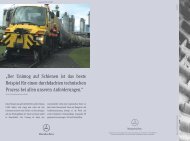Unimog
Download magazine - Mercedes-Benz
Download magazine - Mercedes-Benz
- No tags were found...
You also want an ePaper? Increase the reach of your titles
YUMPU automatically turns print PDFs into web optimized ePapers that Google loves.
Road-rail applications<br />
off the road neatly, the asphalt was previously<br />
broken up and the shoulder was a serious<br />
danger to passing vehicles.<br />
In addition to carrying the complete combination of<br />
equipment, the <strong>Unimog</strong> U 500 propels the truck with<br />
its tipping semi-trailer<br />
Achim Rosinsky is one of those young and<br />
flexible businessmen who manage the use of<br />
their vehicles from their “mobile office” – in<br />
his case, an off-roader – and travel to every<br />
construction site to discuss questions and<br />
problems with their customers on the spot.<br />
He owns 27 commercial vehicles, from narrow-track<br />
implement carriers to heavy goods<br />
trucks, including a semi-trailer tractor with a<br />
low-bed trailer for a maximum load of 62<br />
tonnes. He reserves special affection, however,<br />
for his various <strong>Unimog</strong>s, consisting of a<br />
U 1700 L, a U 406, a U 140 and a U 90 in<br />
addition to the U 500 mentioned above. They<br />
are used for winter service, sweeping, work<br />
with a grader blade installed between the<br />
axles, construction-site services and general<br />
transport tasks. This customer’s close relationship<br />
with his machinery is also due to<br />
<strong>Unimog</strong> general agent Meineke’s excellent<br />
customer support: Christian Rabe will<br />
provide assistance anywhere and attend<br />
promptly to any inquiry concerning the<br />
<strong>Unimog</strong> and its diverse applications. ■<br />
Moved as if by magic<br />
A road-rail <strong>Unimog</strong> is used for shunting in the port of Stralsund<br />
Anew kind of vehicle has now put in an<br />
appearance at the port of Stralsund. In<br />
the past, former Reichsbahn locomotives<br />
used to sound their horns, but since mid-<br />
2003, a road-rail <strong>Unimog</strong> has been used at<br />
the transhipment port operated by the Stralsunder<br />
Hafen- und Lagerhausgesellschaft<br />
(SHL). The <strong>Unimog</strong> for combined road and<br />
rail use is the economical solution for the<br />
implementation of an international business<br />
agreement. A five-year contract between<br />
SHL and a Norway-based company for the<br />
import of 100,000 tonnes of limestone per<br />
year via this port came into effect at the<br />
beginning of 2003.<br />
Various building materials including gypsum<br />
plaster board are produced in Drammen,<br />
on the Oslo fjord. The two 5,000-ton<br />
Norwegian bulk carriers “Marble Bay” and<br />
“Marble Sea” take turns to perform the<br />
weekly run to the North. Their destination is<br />
Jänschwalde power station in the State of<br />
Brandenburg. Once the gypsum has been<br />
discharged, the train is loaded again. Dieter<br />
Böse is delighted with this successful deal:<br />
“There are no empty movements – the transport<br />
cycle is complete.” Every working day, a<br />
1,800-ton train with 30 freight cars rolls into<br />
the harbour. A locomotive would normally be<br />
needed to shunt these, but since the big<br />
diesel locomotives turned out to be too<br />
expensive and too clumsy, SHL looked for an<br />
alternative and found it at Schoknecht in<br />
Demmin, the <strong>Unimog</strong> general agent for Western<br />
Pomerania. The <strong>Unimog</strong>, with rail guidance<br />
by <strong>Unimog</strong> System Partner Zwiehoff,<br />
can be driven on the road with its rubber<br />
tyres as well as on its steel rail wheels, and<br />
proved to be the ideal solution. It was tested<br />
for eight weeks at the dockside and gave<br />
such good results that SHL’s CEO Wolfgang<br />
Ostenberg decided to purchase it.<br />
Since then, many car drivers have been<br />
surprised to see this brand-new cross<br />
between a road vehicle and a locomotive suddenly<br />
appear in front of them on the transverse<br />
canal bridge, pulling a freight train.<br />
Its power output of 130 kW (177 hp) is fully<br />
adequate for the purpose. There is no driver<br />
anywhere in sight; instead, one of SHL’s<br />
eight shunting controllers trained by the<br />
Deutschen Bahn AG wears a remote control<br />
around his neck to move the 1,800-ton train<br />
and to control the separate air pressure system<br />
for opening and closing the freight car<br />
bodies at the touch of a button.<br />
According to Dieter Böse, the 200,000 Euro<br />
investment has definitely paid off, with<br />
prospects of a ten-year contract with this<br />
Norwegian client.<br />
■<br />
Top left: Shunting a 1,800-ton train; the historic<br />
“Alte Lotsenwache” (the former pilots’ building) can<br />
be seen in the background<br />
Top right: The SHL’s <strong>Unimog</strong> is remote-controlled<br />
Bottom: Mercedes-Benz encounter on transverse canal<br />
bridge in the port of Stralsund<br />
<strong>Unimog</strong> 2|2003 13





